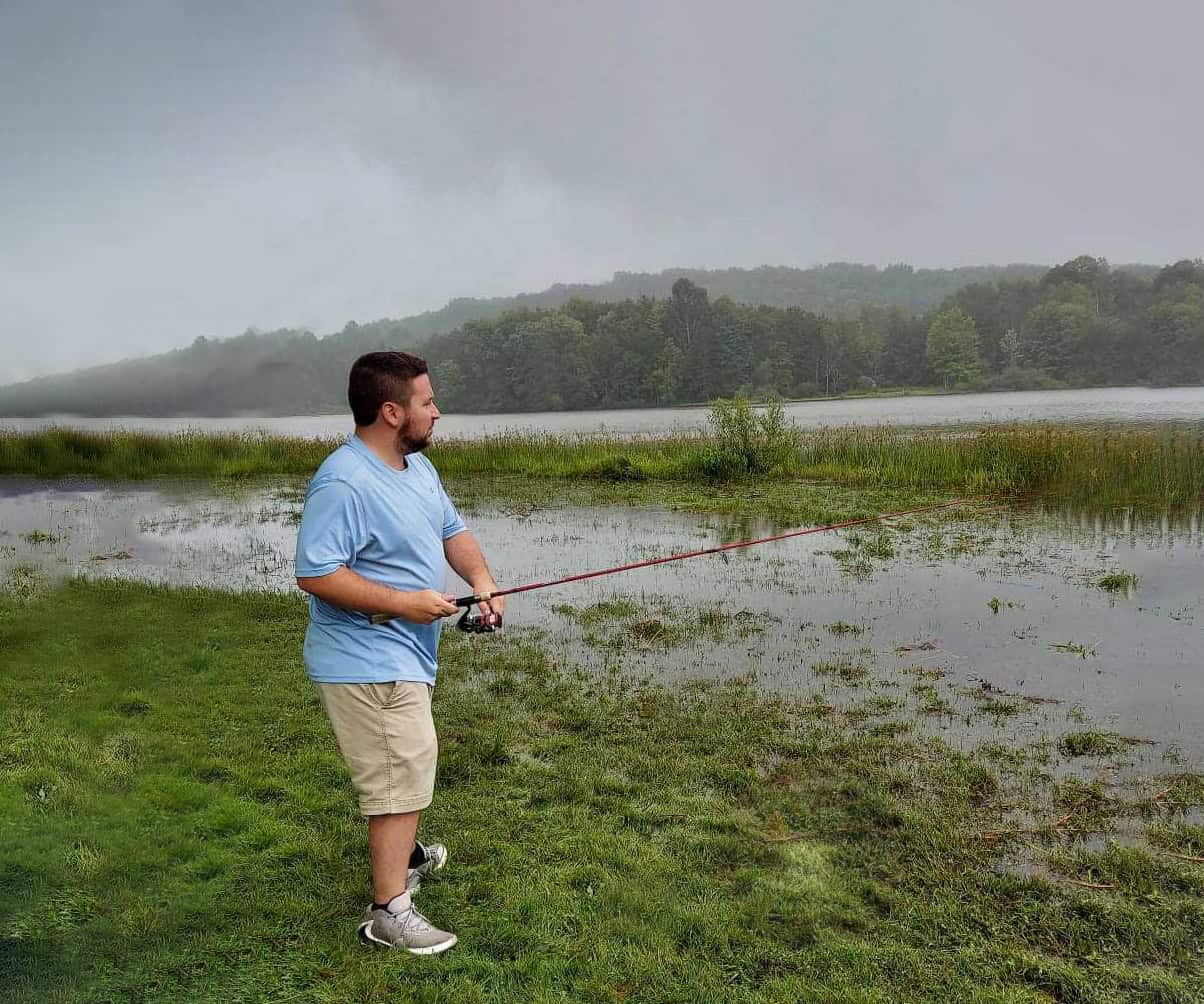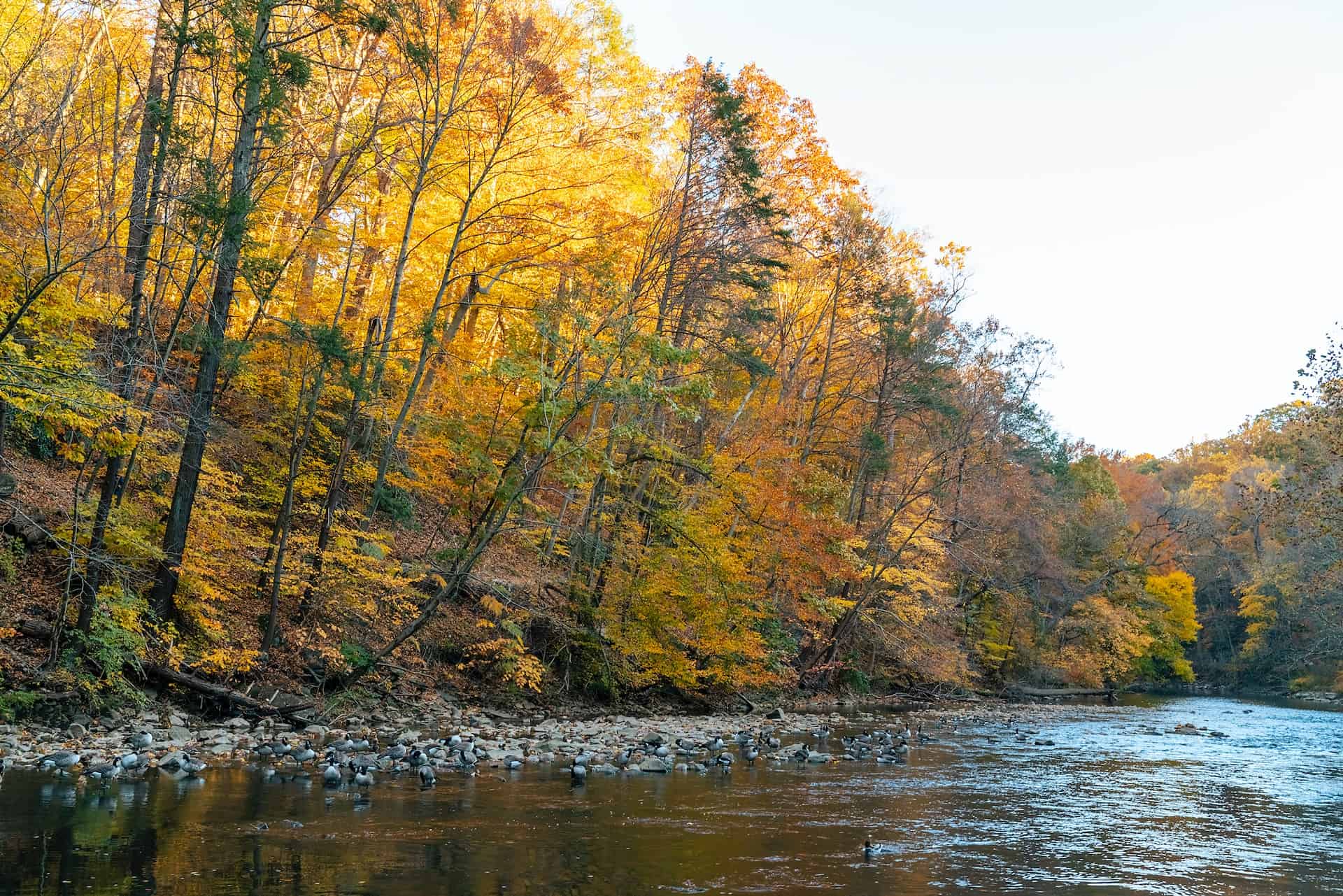Folks, few hikes are more scenic and exciting than the 200+ miles of the Appalachian Trail (AT) through the rolling hills of Pennsylvania in the United States.
Hiking the Pennsylvania portion of the trail offers diverse landscapes, including rocky ridges, rolling farmland, dense forests, and picturesque lakes.
One of the things that stood out to me most on my first-ever hike through the trail was the sheer amount of great fishing opportunities that most people overlook: Boiling Springs, Lehigh, Delaware Water Gap, Pine Grove Furnace, and more.
How can someone like me, who grew up nearly 10 miles away from an Appalachian Trail access point, never step foot on this trail until his early 20s?
I repeatedly asked this question with the crunch of each piece of gravel beneath my boot.
Table of Contents
The Beauty of Fishing and Hiking
Hiking and fishing, seemingly disparate pursuits, converge harmoniously along the Appalachian Trail in Pennsylvania.
The trail, known for its breathtaking vistas and diverse ecosystems, provides a canvas for the perfect blend of adventure and serenity.
The marriage of hiking and fishing in this region creates an experience that taps into the thrill of discovery and the soothing rhythm of nature.

Nestled within the picturesque Cumberland Valley, Boiling Springs is a gateway to the Appalachian Trail's aquatic wonders. As dawn breaks, illuminating the landscape with the soft hues of early morning, hikers and anglers alike find themselves drawn to the shores of Boiling Springs Lake. Here, the dance of mist on the water's surface creates an ethereal ambiance, setting the stage for a day of exploration.
As someone who always considered himself an angler first, the potential to hook a trophy-sized bass or a gorgeous rainbow trout in the still waters had my mouth watering.
With Senko worm, 10lb monofilament, and ultralight spinning reel in hand, I did what I do best. I threw a beautiful lure out beneath the branches of low-hanging longleaf pine.
Within seconds I hooked what I believed at the time to be a walleye. It was slightly chilly out in early spring, so I believe this contributed to the change in expected species.
After about four minutes of battling back and forth, I finally met my match. My line snapped, I lost my lure, and I never saw that fish again.
The moral of the story is that it's not always about the catch but the journey to the catch.
Top Fishing Spots on the Appalachian Trail
As you read my story, I hope you feel inspired to check out some of these amazing destinations.
The Appalachian Trail in Pennsylvania isn't typically a bucket list item for anglers. Still, it didn't take long to realize that there is a ton of unspoiled opportunity along this dusty path.

Boiling Springs Lake
Located near the small town of Boiling Springs in Cumberland County, west of the Susquehanna River, this serene lake offers a tranquil escape for both hikers and anglers.
The calm waters are perfect for fishing, reflecting the surrounding greenery and creating a soothing atmosphere.
Boiling Springs Lake is renowned for its trout fishing, particularly stocked rainbow and brown trout.
The peaceful ambiance and easy access from the Appalachian Trail make it an excellent spot for a leisurely afternoon of fishing.
Lehigh River Gap
The Lehigh River flows through the dramatic Lehigh Gap, an area the AT crosses. The river offers diverse fishing opportunities, including trout and smallmouth bass.
The Lehigh Gap's rugged landscape adds an element of adventure to the fishing experience.
Anglers can expect to catch trout, bass, and other fish species amidst the stunning backdrop of the gap's rocky terrain.
Delaware Water Gap
Situated along the border between Pennsylvania and New Jersey, the Delaware Water Gap is a picturesque destination for fishing enthusiasts.
The Delaware River is home to a variety of fish species, making it a versatile spot for angling. Trout, bass, walleye, and catfish are among the species found in the river's waters.
The convergence of beautiful scenery and abundant fishing opportunities makes this area a must-visit for hikers and anglers alike.
Yellow Breeches Creek
Near Boiling Springs, Yellow Breeches Creek is a renowned trout fishery. Its cold, clear waters provide an ideal habitat for trout, and the creek is regularly stocked to maintain healthy populations.
Fly fishing is especially popular here, and the creek's accessible location and vibrant trout population make it an attractive option for anglers looking for a rewarding catch.
Pine Grove Furnace State Park
This state park has two lakes, Laurel Lake and Fuller Lake. Laurel Lake is often stocked with trout, creating a prime fishing destination for those seeking a serene angling experience.
Both lakes provide opportunities for shore fishing and canoeing. The picturesque surroundings and well-maintained facilities enhance the overall fishing experience.
Glen Onoko Falls
As the trail passes by Glen Onoko Falls, anglers can explore fishing opportunities in the Lehigh River's rapids and pools.
This is a personal favorite of mine because the dynamic environment offers a unique angling experience, where the rushing waters and shaded pools provide a habitat for various fish species.
It's a spot where the thrill of fishing combines with the excitement of navigating the river's features.
Penn's Creek
While not directly on the Appalachian Trail, Penn's Creek is a renowned fly-fishing destination in Pennsylvania.
Known for its excellent hatches of insects and robust trout populations, this creek draws anglers seeking a more specialized and technical fishing experience.
Its waters are home to wild brown trout and other species, making it a challenging yet rewarding spot for skilled fly fishers.
Tips to Take With You

As the butterflies in your stomach settle, I want to provide some actionable tips to help you.
Leave No Trace: The Appalachian Trail is a cherished natural resource, so following Leave No Trace principles is crucial.
Pack out all trash, including fishing lines and any packaging, to help preserve the environment for future generations.
Know The Rules: Before you start fishing, familiarize yourself with the fishing regulations of the specific areas along the AT. The Appalachian Trail Conservancy and National Park Service websites are great resources.
Regulations can vary based on the body of water, your target species, and the time of year. Ensure you have the appropriate fishing licenses and adhere to catch limits and size restrictions.
Adapt to Conditions: Weather and water conditions can change rapidly. Be prepared for varying conditions, and adjust your fishing tactics accordingly.
For example, if the water is murky, consider using lures with bright colors or rattling features to attract fish.
Practice Catch and Release: If you're not keeping your catch, practice proper catch and release techniques.
Handle the fish gently, avoid removing them from the water for extended periods, and use barbless hooks to minimize injury.
If I could leave you with one takeaway, it would be to share this time with family and friends.
The Appalachian Trail is a strenuous hike, but through the north and northeastern portion of Pennsylvania, it's not as bad as you would think.
It lives up to its expectations, and the abundance of fishing opportunities might surprise you. Good luck and enjoy!
For Coty, he didn't love bass fishing at first cast. It took a few (thousand) throws for him to become obsessed with mastering every possible fishing style, technique, and lure. As a third-generation angler and the Managing editor of Anglers. He has a plethora of knowledge and experience on the water and loves sharing what he knows.
Planning a trip? Go Backpacking recommends:
- G Adventures for small group tours.
- Hostelworld for booking hostels.
